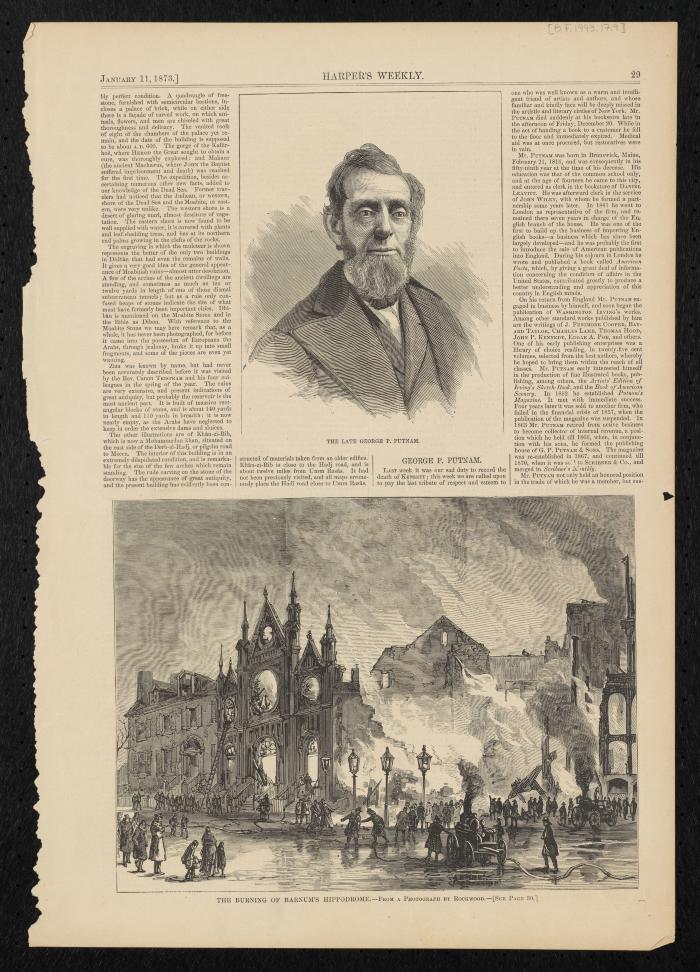Newspaper: Harper's Weekly for January 11, 1873 with illustration entitled "The Burning of Barnum's Hippodrome"
January 11 1873 (Date manufactured/created)
paper
Illustrated article from the January 11, 1873, edition of Harper’s Weekly describing and depicting the fire that consumed P. T. Barnum's Hippodrome in New York City. According to the caption, the illustration on page 29 is an engraving made from a photograph by Rockwood. The scene depicts the shell of a huge, badly damaged building with firefighters putting out the fire while a crowd of onlookers observes the destruction. A brief accompanying article appears on the next page (page 30), titled "THE HIPPODROME BURNED." The account states that the fire began at 4 a.m. on December 24, 1872, and quickly became a "bonfire" that consumed four buildings. Only two elephants of the many wild and exotic animals in Barnum's Hippodrome survived.
P. T. Barnum is best known today for the Barnum & Bailey Greatest Show on Earth, but his circus ventures did not come about until he was in his early 60s. His first circus, in the early 1870s, was called P. T. Barnum’s Grand Traveling Museum, Menagerie, Caravan and Circus. Barnum subsequently opened the New York Hippodrome with similar acts. In the 1880s, competition from other circuses increased. A merger between Barnum’s show and the Great London Show of Cooper, Bailey, and Hutchinson formed the circus called Barnum & London. America's new and ever-growing railroad system propelled the circus to success, making it possible to add destinations and reach distant locations, as well as transport many more circus wagons, animals, equipment, tent canvas, performers and support staff. Barnum's partnership with James A. Bailey in 1887 formed Barnum & Bailey, which continued to be managed by Bailey after Barnum's death in 1891. After Bailey's death in 1906, the Ringling Brothers bought Barnum & Bailey and operated it separately from their own circus. In 1919 the two were combined to form Ringling Bros. and Barnum & Bailey Greatest Show on Earth. That circus gave its final performance on May 21, 2017.
P. T. Barnum is best known today for the Barnum & Bailey Greatest Show on Earth, but his circus ventures did not come about until he was in his early 60s. His first circus, in the early 1870s, was called P. T. Barnum’s Grand Traveling Museum, Menagerie, Caravan and Circus. Barnum subsequently opened the New York Hippodrome with similar acts. In the 1880s, competition from other circuses increased. A merger between Barnum’s show and the Great London Show of Cooper, Bailey, and Hutchinson formed the circus called Barnum & London. America's new and ever-growing railroad system propelled the circus to success, making it possible to add destinations and reach distant locations, as well as transport many more circus wagons, animals, equipment, tent canvas, performers and support staff. Barnum's partnership with James A. Bailey in 1887 formed Barnum & Bailey, which continued to be managed by Bailey after Barnum's death in 1891. After Bailey's death in 1906, the Ringling Brothers bought Barnum & Bailey and operated it separately from their own circus. In 1919 the two were combined to form Ringling Bros. and Barnum & Bailey Greatest Show on Earth. That circus gave its final performance on May 21, 2017.
BF 1993.017.009.004
